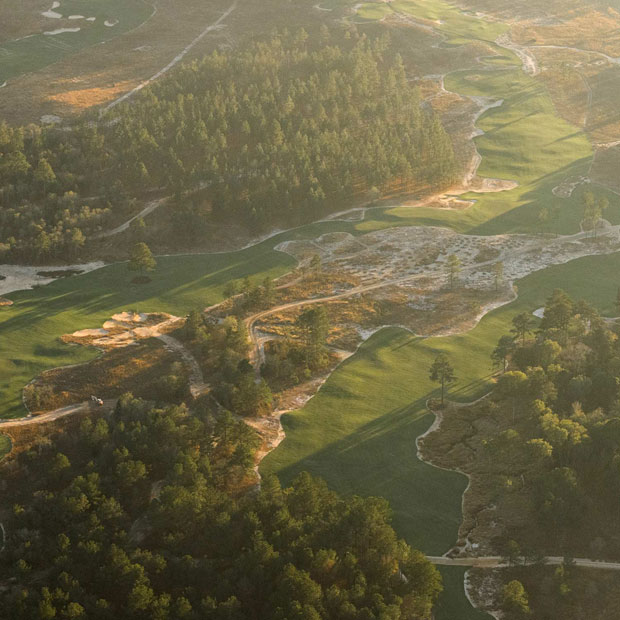A Neighborhood Nine vs. the Pandemic
Laurelwood Golf Course was on the rise—and then COVID-19 hit


Will Benson was in the Pub at Laurelwood Golf Course when Nick Sams laid off his 15 restaurant employees. Sams gave each person two beers and a portion of the leftover food. Benson, the golf course superintendent, overheard a few of the workers discussing their plans.
“Are you going to pay your rent?” one of them asked the others.
Everyone agreed. “No.”
“And then I realized,” Benson says, “besides the illness and death, this was going to be an economic disaster, too.”
It was March 16, 2020. Earlier that day, in response to the rising threat from the coronavirus pandemic, Oregon Governor Kate Brown had restricted all restaurants in the state to carry-out only. The Pub at Laurelwood had to close.
“It was one of the top three crushing things I’ve witnessed,” Benson says.
The golf course itself stayed open for another week. Then on March 22, Benson and Sams—along with Jeff Oliver, who operates the pro shop—decided to close entirely. It was their call. The three of them run Laurelwood Golf Course for the city of Eugene, but they have not heard anything from the local government. “We haven’t asked,” Benson says, “and they haven’t told us.”
Benson came on as superintendent at Laurelwood 13 years ago. Back then, the property was in serious distress, but he has gradually brought it back around. Now, with COVID-19 consigning the golf world to a strange, anxious limbo, he is wondering how much of his hard work will go up in smoke.

The 1st tee at Laurelwood on a recent rainy day. Photo credit: Will Benson
Laurelwood to Laurelweed, and back again
By the turn of the 21st century, nine-hole Laurelwood had lost nearly all of its bunkers. One of the few that remained was in the shape of a heart. Out-of-place poplars and arborvitaes, cast-offs from a nearby home improvement store, dotted the property. Most of the greens were flattish discs. Where natural creeks used to run, there was nothing but the occasional puddle.
“It was known as a soggy mess,” Benson recalls. “And there were English daisies everywhere. Everyone would joke you couldn’t even find your ball in the fairway, there were so many daisies. It was your stereotypical nine-hole beaten-down muni.” Locals took to calling it “Laurelweed.”
But the course had a lot going for it. It was casual, friendly, and welcoming to neighborhood families and their dogs. The hillside property was rolling and varied, and in spite of the tree plantings, the corridors remained fairly open, offering views of the surrounding mountains. Each hole sat on the terrain in its own, distinctive way. There was potential here—and, as Benson found out through his own research, substantial history.
In the 1920s, Eugene’s golf scene was small but growing. Eugene Country Club boasted a fine 18-hole course designed by H. Chandler Egan, the Pacific Northwest’s leading golf architect. Egan had worked with Alister MacKenzie and headed up the famous late-’20s renovation of Pebble Beach. Like MacKenzie, Egan cultivated a network of associates, and his man in Eugene was Clarence Sutton, who had helped with the construction of Eugene CC. In 1929, Sutton unveiled his own design at Laurelwood Golf and Country Club.
Originally an 18-hole public course, Laurelwood became a Eugene institution. It hosted numerous high-school tournaments as well as state and regional championships. After World War II, however, the course struggled, changing hands every few years. It lost one of its nines in 1958, and some of the remaining holes had to be rerouted. Yet Laurelwood managed to survive, if barely, until Will Benson arrived in 2007.
While he knew he could not recover Clarence Sutton’s exact design, Benson took courage from Laurelwood’s architectural heritage. This wasn’t your typical local nine. It was a special, historically significant place, and he was its steward.
Benson and his crew got to work. They mended the drainage system, improved turf conditions while reducing pesticide use, and removed the small trees that had been added in the ’00s. As the course became more functional, Benson sought to make it more interesting. He expanded greens and restored bunkers, trying to offer better players more variety and challenge. At the same time, he left plenty of room for less skilled golfers to plod along. “You can hit 170-yard drives all day long and you’re not going to get in any trouble,” Benson explains. “But if you’re better and you’re hitting it 230, 250, there’s some trouble out there.”
{{content-block-laurelwood-golf-course-coronavirus-covid-19-001}}
Over the past couple of years, Benson addressed some serious traffic and safety problems on holes 7 through 9. The 7th hole was a drivable par 4, so groups often piled up there. To make matters worse, players often walked backwards through the 7th fairway to reach the 8th tee. The 9th hole was an uphill, blind par 3 with a green wedged between the clubhouse and a neighbor’s fence. Wayward balls frequently pelted the restaurant.
So Benson proposed a rerouting: lengthen the 7th hole by moving the tee back to its original position; build a new 8th hole, a par 3 playing from behind the 7th green to a section of the property previously used as a dump; and make the 9th hole a short, twisty par 5 finishing at the base of the hill. It was a safer, more efficient routing.
{{content-block-laurelwood-golf-course-coronavirus-covid-19-002}}
As part of a new management contract in 2018, Benson and his partners Nick Sams and Jeff Oliver asked for $100,000 from the city of Eugene to support the renovation. To their mild surprise, they received it. By drawing on an additional $44,000 of unused past funding and keeping most of the labor in-house, they were able to pursue an array of improvements—not only the rerouting but also a creek restoration on the 6th hole.
{{content-block-laurelwood-golf-course-coronavirus-covid-19-003}}
For the detail work, Benson knew he would need an actual architect. His top choice was Dan Hixson, who has become a kind of 21st-century Chandler Egan. Hixson has worked almost exclusively in Oregon and Washington, and his outstanding designs at Bandon Crossings and Wine Valley have flown under the radar outside of the Pacific Northwest. When Benson called him, Hixson had just finished his highest-profile project to date, a reversible course at Silvies Valley Ranch. It turned out that the architect had a personal connection to Laurelwood: his father had been an assistant pro there in the 1950s. Hixson took the job.
With a rented Cat and some dirt borrowed from a basement installation down the street, he sculpted the new greens and tees.
{{content-block-laurelwood-golf-course-coronavirus-covid-19-004}}
Benson was delighted with the results. “I was on the patio last year,” he recalls, “and one guy—he didn’t even know I was there—he mentioned to someone, ‘Well, if they hadn’t done the reroute, I wouldn’t have bought a membership here.’”
Last month, Hixson returned to Laurelwood to discuss changes to the bunkering on the 6th hole. Benson had intended to call Hixson the next week to give the go-ahead. “And then this whole thing hit. I texted Dan the other day and said, ‘Amazing how things changed in one week.’ He was like, ‘I know.’”
Indefinite hiatus
In this time of self-isolation, golf courses find themselves in an ambiguous position. Golf, like hiking and cycling, is socially distant by design. Some have suggested that it is the ideal pastime for the COVID-19 era. Others have pointed out that courses don’t maintain themselves, and that we can’t just ignore the risks to greenkeepers. Plus, in order to call golf safe, you have to assume that everyone will follow the rules. That’s a big assumption.
The debate is ongoing. Meanwhile, in states that have not explicitly banned golf, courses have had to make their own decisions.
On the weekend of March 21-22, several days after the Pub at Laurelwood closed, the sun came out in Eugene, and the golf course was busy. Will Benson’s staff repeatedly doused the carts with disinfectant. They removed all bunker rakes and turned the cups upside down. No benches, no ball washers. Yet as Benson watched golfers line up in the pro shop, he didn’t feel right. “I’m just like, ‘God’…”
Benson is more attuned to the invisible dangers than most. His wife is a charge nurse at a local hospital, and she has been reassigned to thermometer duty. For Benson, the prospect of a sudden deluge of patients descending on hospitals, begging for beds and ventilators, is a personal one. While the incidence of COVID-19 in Oregon remains fairly low (as does the rate of testing), you can never predict when the exponential burst might arrive. “They’re just kind of waiting,” Benson says.
So as Laurelwood filled with golfers two weekends ago, his mind began to race. “There were just so many points of transmission. The cash register. We’re not serving beer anymore, so people are stopping at convenience stores and buying beer. Then they’re putting beer cans in the garbage cans, and my employees have to pick them up. Do they wear gloves? Do they take the gloves off and wipe their face? The driving range. Do you have to sterilize every single range ball? What about the stupid rubber tees? Do you get rid of the rubber tees? Do you put them in bleach buckets? It’s too many questions. I just felt like it wasn’t in control.” On Sunday afternoon, March 22, Laurelwood’s management team agreed to close.

The view from the new 7th tee at Laurelwood. Photo credit: Will Benson
The next day, Benson was back at the course. “I just started getting back to work,” he explains. “I don’t know what else to do, you know?” Since then, with occasional help from his small crew, he has kept things humming along. Mowing tees. Repairing irrigation. Mowing fairways. Spraying greens. Mowing rough. Telling everyone to stay away from the office.
A few other courses in the area have remained open. Benson hears they’re busy, and he wishes local or state governments would take a clearer stance. “I understand that people want to go outside,” he says. “But I mean, is [golf] safe or is it not safe? I don’t know. Doesn’t seem like it.”
For now, Laurelwood is marking time. “We have a little money aside,” Benson says, “so we can float for a little while.” But he, Sams, and Oliver—like most people whose livelihoods are bound up in small businesses—are wondering how long they can go without revenue. Their strategy in recent years has been to invest in their product, not to pile up savings. It was the only way to grow, and it was working. But no small business, much less a neighborhood golf course, has a contingency plan for a pandemic.
“I’ve got an idea in my head of how I want it to go down,” Benson says, “but I have to be flexible because I have no idea what’s coming.”
Leave a comment or start a discussion
Engage in our content with thousands of other Fried Egg Golf Club Members
Engage in our content with thousands of other Fried Egg Golf Members
Get full access to exclusive benefits from Fried Egg Golf
- Member-only content
- Community discussions forums
- Member-only experiences and early access to events












Leave a comment or start a discussion
Lorem ipsum dolor sit amet, consectetur adipiscing elit. Suspendisse varius enim in eros elementum tristique. Duis cursus, mi quis viverra ornare, eros dolor interdum nulla, ut commodo diam libero vitae erat. Aenean faucibus nibh et justo cursus id rutrum lorem imperdiet. Nunc ut sem vitae risus tristique posuere. uis cursus, mi quis viverra ornare, eros dolor interdum nulla, ut commodo diam libero vitae erat. Aenean faucibus nibh et justo cursus id rutrum lorem imperdiet. Nunc ut sem vitae risus tristique posuere.